
Coming Soon
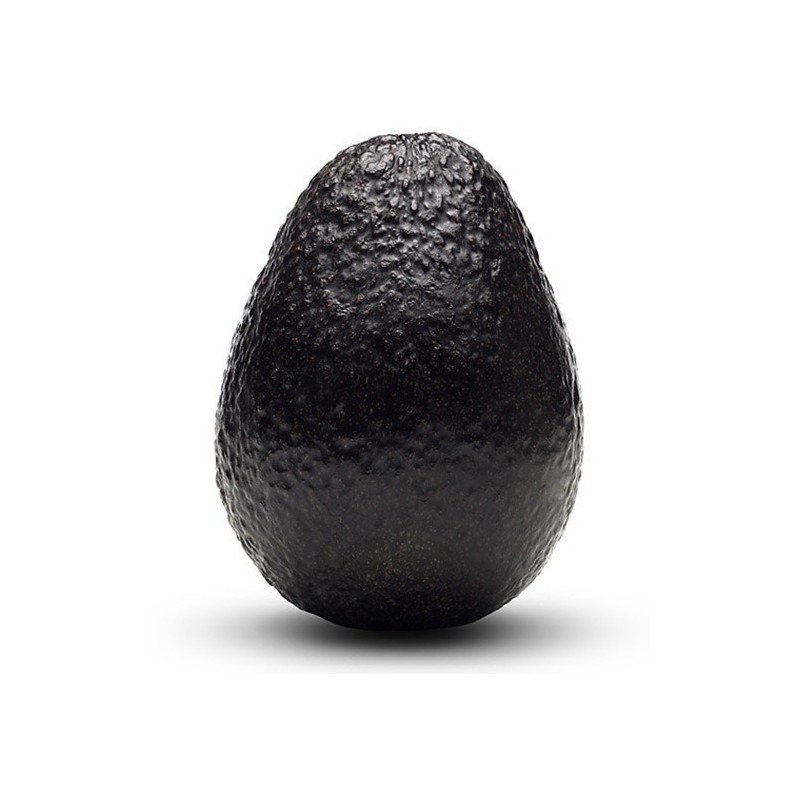






The avocado (Persea americana) is a tree, long thought to have originated in South Central Mexico, classified as a member of the flowering plant family Lauraceae. The fruit of the plant, also called an avocado
The avocado (Persea americana) is a tree, long thought to have originated in South Central Mexico, classified as a member of the flowering plant family Lauraceae. The fruit of the plant, also called an avocado (or avocado pear or alligator pear), is botanically a large berry containing a single large seed.
Avocados are commercially valuable and are cultivated in tropical and Mediterranean climates throughout the world.[4] They have a green-skinned, fleshy body that may be pear-shaped, egg-shaped, or spherical. Commercially, they ripen after harvesting. Avocado trees are partially self-pollinating and are often propagated through grafting to maintain a predictable quality and quantity of the fruit.
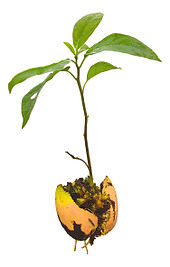
Persea americana is a tree that grows to 20 m (66 ft), with alternately arranged leaves 12–25 cm (4.7–9.8 in) long. Panicles of flowers with deciduous bracts arise from new growth or the axils of leaves.[6] The flowers are inconspicuous, greenish-yellow, 5–10 mm (0.2–0.4 in) wide.
The species is variable because of selection pressure by humans to produce larger flesher fruits with a thinner exocarp.[7] The avocado fruit is a climacteric,[8] single-seeded berry, due to the imperceptible endocarp covering the seed,[5][9] rather than a drupe.[10] The pear-shaped fruit is 7–20 cm (2.8–7.9 in) long, weighs between 100 and 1,000 g (3.5 and 35.3 oz), and has a large central seed, 5–6.4 cm (2.0–2.5 in) long.[4]
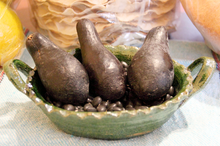
Persea americana, or the avocado, possibly originated in the Tehuacan Valley[11] in the state of Puebla, Mexico,[12] although fossil evidencesuggests similar species were much more widespread millions of years ago. However, there is evidence for three possible separate domestications of the avocado, resulting in the currently recognized Mexican (aoacatl), Guatemalan (quilaoacatl), and West Indian (tlacacolaocatl) landraces.[13][14] The Mexican and Guatemalan landraces originated in the highlands of those countries, while the West Indian landrace is a lowland variety that ranges from Guatemala, Costa Rica, Colombia, Ecuador to Peru,[13] achieving a wide range through human agency before the arrival of the Europeans.[14] The three separate landraces were most likely to have already intermingled[a] in pre-Columbian America and were described in the Florentine Codex.[14]
The earliest residents were living in temporary camps in an ancient wetland eating avocados, chilies, mollusks, sharks, birds, and sea lions.[15] The oldest discovery of an avocado pit comes from Coxcatlan Cave, dating from around 9,000 to 10,000 years ago.[11][14] Other caves in the Tehuacan Valley from around the same time period also show early evidence for the presence of avocado.[11] There is evidence for avocado use at Norte Chico civilization sites in Peru by at least 3,200 years ago and at Caballo Muerto in Peru from around 3,800 to 4,500 years ago.[11]
The native, undomesticated variety is known as a criollo, and is small, with dark black skin, and contains a large seed.[16] It probably coevolved with extinct megafauna.[17] The avocado tree also has a long history of cultivation in Central and South America, likely beginning as early as 5,000 BC.[12] A water jar shaped like an avocado, dating to AD 900, was discovered in the pre-Incan city of Chan Chan.[18]
The earliest known written account of the avocado in Europe is that of Martín Fernández de Enciso (circa 1470–1528) in 1519 in his book, Suma De Geographia Que Trata De Todas Las Partidas Y Provincias Del Mundo.[19][20] The first detailed account that unequivocally describes the avocado was given by Gonzalo Fernández de Oviedo y Valdés in his work Sumario de la natural historia de las Indias in 1526.[13] The first written record in English of the use of the word 'avocado' was by Hans Sloane, who coined the term in 1669,[13] in a 1696 index of Jamaican plants. The plant was introduced to Spain in 1601, Indonesia around 1750, Mauritius in 1780, Brazil in 1809, the United States mainland in 1825, South Africa and Australia in the late 19th century, and Israel in 1908.[14] In the United States, the avocado was introduced to Florida and Hawaii in 1833 and in California in 1856.[14]
Before 1915, the avocado was commonly referred to in California as ahuacate and in Florida as alligator pear. In 1915, the California Avocado Association introduced the then-innovative term avocado to refer to the plant.[14]
The word "avocado" comes from the Spanish aguacate, which in turn comes from the Nahuatl word āhuacatl [aːˈwakat͡ɬ],[21] which goes back to the proto-Aztecan *pa:wa which also meant "avocado".[22] Sometimes the Nahuatl word was used with the meaning "testicle", probably because of the likeness between the fruit and the body part.[23]
The modern English name comes from an English rendering of the Spanish aguacate as avogato. The earliest known written use in English is attested from 1697 as "avogato pear", a term which was later corrupted as "alligator pear".[24] Because the word avogato sounded like "advocate", several languages reinterpreted it to have that meaning. French uses avocat, which also means lawyer, and "advocate" — forms of the word appear in several Germanic languages, such as the (now obsolete) German Advogato-Birne, the old Danish advokat-pære (today it is called avocado) and the Dutch advocaatpeer.[25]
In other Central American and Caribbean Spanish-speaking countries, it is known by the Mexican name, while South American Spanish-speaking countries use a Quechua-derived word, palta. In Portuguese, it is abacate. The fruit is sometimes called an avocado pear or alligator pear (due to its shape and the rough green skin of some cultivars).[4] The Nahuatl āhuacatl can be compounded with other words, as in ahuacamolli, meaning avocado soup or sauce, from which the Spanish word guacamole derives.[26]
In the United Kingdom, the term avocado pear is still sometimes misused as applied when avocados first became commonly available in the 1960s.[27]
Originating as a diminutive in Australian English, a clipped form, avo, has since become a common colloquialism in South Africa and the United Kingdom.
It is known as "butter fruit" in parts of India and goes by the name bơ [ɓɘː] in Vietnamese, which is the same word that is used for butter.[28] In eastern China, it is known as è lí (鳄梨; 鱷梨; "alligator pear") or niú yóu guǒ(牛油果; "butter fruit"). In Taiwan, it is known as luò lí (酪梨, "cheese pear").
The subtropical species needs a climate without frost and with little wind. High winds reduce the humidity, dehydrate the flowers, and affect pollination. When even a mild frost occurs, premature fruit drop may occur, although the 'Hass' cultivar can tolerate temperatures down to −1 °C. Several cold-hardy varieties are planted in the region of Gainesville, Florida, which survive temperatures as low as −6.5 °C (20 °F) with only minor leaf damage. The trees also need well-aerated soils, ideally more than 1 m deep. Yield is reduced when the irrigation water is highly saline. These soil and climate conditions are available in southern and eastern Spain, Morocco, the Levant, South Africa, Venezuela, Colombia, Peru, parts of central and northern Chile, Vietnam, Indonesia, parts of southern India, Sri Lanka, Australia, New Zealand, the Philippines, Malaysia, Central America, the Caribbean, Mexico, southern California, Arizona, Puerto Rico, Texas, Florida, Hawaii, Ecuador, and Rwanda. Each region has different cultivars.[citation needed]
Commercial orchards produce an average of seven tonnes per hectare each year, with some orchards achieving 20 tonnes per hectare.[29] Biennial bearing can be a problem, with heavy crops in one year being followed by poor yields the next.
Like the banana, the avocado is a climacteric fruit, which matures on the tree, but ripens off the tree. Avocados used in commerce are picked hard and green and kept in coolers at 3.3 to 5.6 °C (37.9 to 42.1 °F) until they reach their final destination. Avocados must be mature to ripen properly. Avocados that fall off the tree ripen on the ground. Generally, the fruit is picked once it reaches maturity; Mexican growers pick 'Hass' avocados when they have more than 23% dry matter, and other producing countries have similar standards. Once picked, avocados ripen in one to two weeks (depending on the cultivar) at room temperature (faster if stored with other fruits such as apples or bananas, because of the influence of ethylene gas). Some supermarkets sell ripened avocados which have been treated with synthetic ethylene to hasten ripening.[30] The use of an ethylene gas "ripening room", which is now an industry standard, was pioneered in the 1980s by farmer Gil Henry of Escondido, California, in response to footage from a hidden supermarket camera which showed shoppers repeatedly squeezing hard, unripe avocados, putting them "back in the bin," and moving on without making a purchase.[31] In some cases, avocados can be left on the tree for several months, which is an advantage to commercial growers who seek the greatest return for their crop, but if the fruit remains unpicked for too long, it falls to the ground.
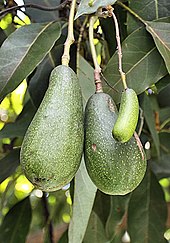
The species is only partially able to self-pollinate because of dichogamy in its flowering. This limitation, added to the long juvenile period, makes the species difficult to breed. Most cultivars are propagated by grafting, having originated from random seedling plants or minor mutations derived from cultivars. Modern breeding programs tend to use isolation plots where the chances of cross-pollination are reduced. That is the case for programs at the University of California, Riverside, as well as the Volcani Centre and the Instituto de Investigaciones Agropecuarias in Chile.
The avocado is unusual in that the timing of the male and female flower phases differs among cultivars. The two flowering types are A and B. A-cultivar flowers open as female on the morning of the first day and close in late morning or early afternoon. Then they open as male in the afternoon of the second day. B varieties open as female on the afternoon of the first day, close in late afternoon and reopen as male the following morning.
Certain cultivars, such as the 'Hass', have a tendency to bear well only in alternate years. After a season with a low yield, due to factors such as cold (which the avocado does not tolerate well), the trees tend to produce abundantly the next season. In addition, due to environmental circumstances during some years, seedless avocados may appear on the trees.[34] Known in the avocado industry as "cukes", they are usually discarded commercially due to their small size.[35]
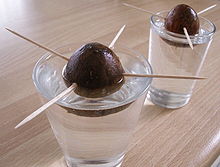
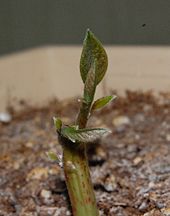
Avocados can be propagated by seed, taking roughly four to six years to bear fruit, although in some cases seedlings can take 10 years to come into bearing.[36] The offspring is unlikely to be identical to the parent cultivar in fruit quality. Prime quality varieties are therefore propagated by grafting to rootstocks that are propagated by seed (seedling rootstocks) or by layering (clonal rootstocks). After about a year of growing in a greenhouse, the young rootstocks are ready to be grafted. Terminal and lateral grafting is normally used. The scion cultivar grows for another 6–12 months before the tree is ready to be sold. Clonal rootstocks are selected for tolerance of specific soil and disease conditions, such as poor soil aeration or resistance to the soil-borne disease (root rot) caused by Phytophthora.
Commercial avocado production is limited to a small fraction of the vast genetic diversity in the species. Conservation of this genetic diversity has relied largely on field collection, as avocado seeds often do not survive storage in seed banks. This is problematic, as field preservation of living cultivars is expensive, and habitat loss threatens wild cultivars. More recently, an alternate method of conservation has been developed based on cryopreservation of avocado somatic embryos with reliable methods for somatic embryogenesis and reconstitution into living trees.[37]
Indoors, an avocado tree is usually grown from the pit of an avocado fruit. This is often done by removing the pit from a ripe, unrefrigerated avocado fruit. The pit is then stabbed with three or four toothpicks, about one-third of the way up from the flat end. The pit is placed in a jar or vase containing tepid water. It should split in four to six weeks and yield roots and a sprout. If there is no change by this time, the avocado pit is discarded. Once the stem has grown a few inches, it is placed in a pot with soil. It should be watered every few days. Avocados have been known to grow large, so owners must be ready to re-pot the plant several times.

Avocado trees are vulnerable to bacterial, viral, fungal, and nutritional diseases (excesses and deficiencies of key minerals). Disease can affect all parts of the plant, causing spotting, rotting, cankers, pitting, and discoloration.[38]
Mexico is by far the world's largest avocado growing country, producing several times more than the second largest producer.[39] In 2013, the total area dedicated to avocado production was 168,155 hectares (415,520 acres), and the harvest was 1.47 million tonnes.[40] The states that produce the most are México, Morelos, Nayarit, Puebla, and Michoacan, accounting for 86% of the total. In Michoacán, the cultivation is complicated by the existence of drug cartels that extort protection fees from cultivators. They are reported to exact 2000 Mexican pesos per hectare from avocado farmers and 1 to 3 pesos/kg of harvested fruit.[41]
The avocado was introduced from Mexico to California in the 19th century, and has become a successful cash crop. About 59,000 acres (240 km2) – some 95% of United States avocado production – is located in Southern California, with 60% in San Diego County.[42][43] Fallbrook, California, claims the title of "Avocado Capital of the World" (also claimed by the town of Uruapan in Mexico[44]), and both Fallbrook and Carpinteria, California, host annual avocado festivals. Avocado is the official fruit of the State of California.[45]
Hass avocado production in Peru encompasses thousands of hectares in central and western Peru.[46] Peru has now become the largest supplier of avocados imported to the European Union and, more recently, has begun to export avocados in significant quantities to North America.
Peru's location near the equator and along the Pacific Ocean creates consistently mild temperatures year round. The soil is rich and sandy and the towering Andes mountains provide a constant flow of pure water for irrigation. Naturally sheltered as it is from heavy rain or freezing temperatures, Peru is an almost perfect climate for the cultivation of avocados.
Hass avocados from Peru are seasonally available to consumers from May through September and are promoted under the auspices of the Peruvian Avocado Commission, headquartered in Washington, D.C.




The avocado tree can be grown domestically and used as a (decorative) houseplant. The pit germinates in normal soil conditions or partially submerged in a small glass (or container) of water. In the latter method, the pit sprouts in four to six weeks, at which time it is planted in standard houseplant potting soil. The plant normally grows large enough to be prunable; it does not bear fruit unless it has ample sunlight. Home gardeners can graft a branch from a fruit-bearing plant to speed maturity, which typically takes four to six years to bear fruit.
Data sheet

 Reviews (0)
Reviews (0)